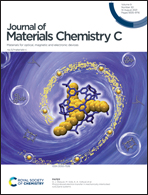Quasiparticle band structures, spontaneous polarization, and spin-splitting in noncentrosymmetric few-layer and bulk γ-GeSe
Abstract
Group-IV monochalcogenides have attracted much attention due to their potential of ferroelectric and multiferroic properties. Recently, centrosymmetric γ-phase GeSe in a double-layer honeycomb lattice has been theoretically predicted, but the synthesized γ-phase GeSe showed a noncentrosymmetric atomic structure, leading to the possibility of ferroelectricity and spin-splitting. Here, we study the quasiparticle band structures, spontaneous polarization, and spin-splitting in noncentrosymmetric γ-GeSe using density functional theory and GW calculations. Our results show that noncentrosymmetric few-layer and bulk γ-GeSe have semiconducting band structures with indirect band gaps, which depend almost linearly on the reciprocal of the number of layers. Spontaneous polarization occurs due to a small charge transfer between the layers, which increases with compressive strain, and ferroelectric switching can be achieved by an interlayer translation with a small energy barrier. Spin-splitting is found to be more significant at the highest valence band than at the lowest conduction band. Our results provide insights into the fundamental electronic properties of a layered ferroelectric semiconductor applicable to devices with ferroelectric/nonferroelectric junctions.



 Please wait while we load your content...
Please wait while we load your content...